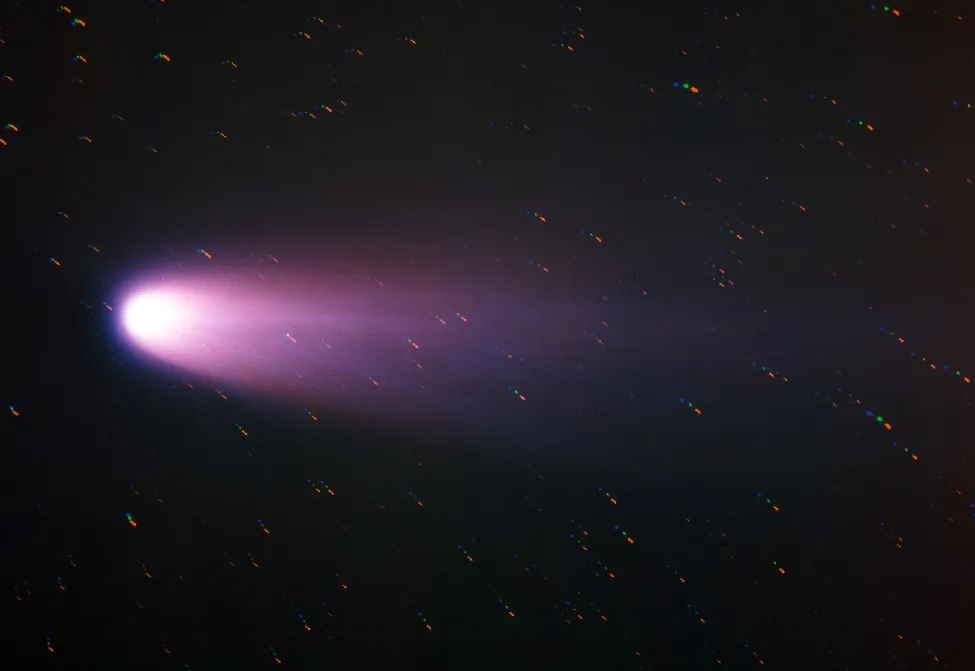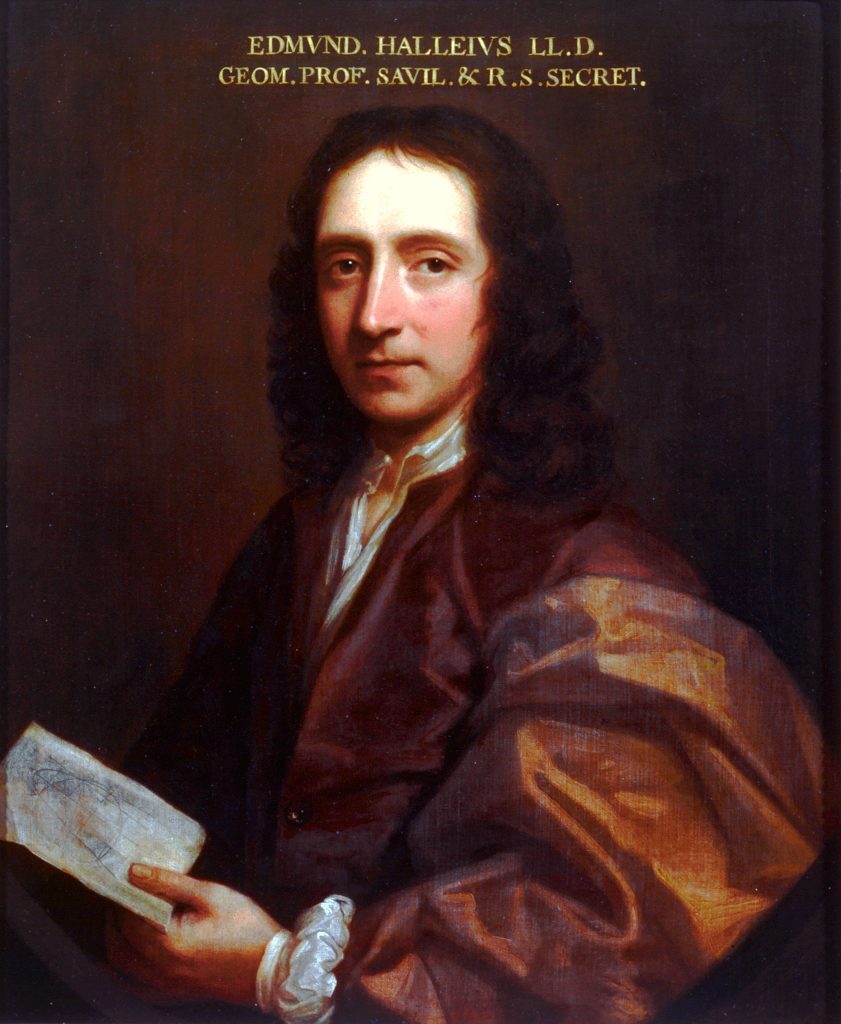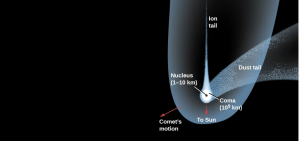8.8 Comets
Comets differ from asteroids primarily in their icy composition, a difference that causes them to brighten dramatically as they approach the Sun, forming a temporary atmosphere. In some early cultures, these so-called “hairy stars” were considered omens of disaster. Today, we no longer fear comets, but eagerly anticipate those that come close enough to us to put on a good sky show.
Appearance of Comets
A comet is a relatively small chunk of icy material (typically a few kilometres across) that develops an atmosphere as it approaches the Sun. Later, there may be a very faint, nebulous tail, extending several million kilometres away from the main body of the comet. Comets have been observed from the earliest times: accounts of comets are found in the histories of virtually all ancient civilizations. The typical comet, however, is not spectacular in our skies, instead having the appearance of a rather faint, diffuse spot of light somewhat smaller than the Moon and many times less brilliant. (Comets seemed more spectacular to people before the invention of artificial lighting, which compromises our view of the night sky.)
Like the Moon and planets, comets appear to wander among the stars, slowly shifting their positions in the sky from night to night. Unlike the planets, however, most comets appear at unpredictable times, which perhaps explain why they frequently inspired fear and superstition in earlier times. Comets typically remain visible for periods that vary from a couple of weeks to several months. We’ll say more about what they are made of and how they become visible after we discuss their motions.
Note that still images of comets give the impression that they are moving rapidly across the sky, like a bright meteor or shooting star. Looking only at such images, it is easy to confuse comets and meteors. But seen in the real sky, they are very different: the meteor burns up in our atmosphere and is gone in a few seconds, whereas the comet may be visible for weeks in nearly the same part of the sky.
Comet Orbits
The study of comets as members of the solar system dates from the time of Isaac Newton, who first suggested that they orbited the Sun on extremely elongated ellipses. Newton’s colleague Edmund Halley developed these ideas, and in 1705, he published calculations of 24 comet orbits. In particular, he noted that the orbits of the bright comets that had appeared in the years 1531, 1607, and 1682 were so similar that the three could well be the same comet, returning to perihelion (closest approach to the Sun) at average intervals of 76 years. If so, he predicted that the object should next return about 1758. Although Halley had died by the time the comet appeared as he predicted, it was given the name Comet Halley (rhymes with “valley”) in honour of the astronomer who first recognized it as a permanent member of our solar system, orbiting around the Sun. Its aphelion (furthest point from the Sun) is beyond the orbit of Neptune.
We now know from historical records that Comet Halley has actually been observed and recorded on every passage near the Sun since 239 BCE at intervals ranging from 74 to 79 years. The period of its return varies somewhat because of orbital changes produced by the pull of the giant planets. In 1910, Earth was brushed by the comet’s tail, causing much needless public concern. Comet Halley last appeared in our skies in 1986 (Figure 8.29), when it was met by several spacecraft that gave us a wealth of information about its makeup; it will return in 2061.
Comet Halley

Comet Halley from La Silla in 1986 by ESO, ESO Media Licence.
Edmund Halley: Astronomy’s Renaissance Man
Edmund Halley (Figure 8.30), a brilliant astronomer who made contributions in many fields of science and statistics, was by all accounts a generous, warm, and outgoing person. In this, he was quite the opposite of his good friend Isaac Newton, whose great work, the Principia, Halley encouraged, edited, and helped pay to publish. Halley himself published his first scientific paper at age 20, while still in college. As a result, he was given a royal commission to go to Saint Helena (a remote island off the coast of Africa where Napoleon would later be exiled) to make the first telescopic survey of the southern sky. After returning, he received the equivalent of a master’s degree and was elected to the prestigious Royal Society in England, all at the age of 22.
In addition to his work on comets, Halley was the first astronomer to recognize that the so-called “fixed” stars move relative to each other, by noting that several bright stars had changed their positions since Ptolemy’s publication of the ancient Greek catalogs. He wrote a paper on the possibility of an infinite universe, proposed that some stars may be variable, and discussed the nature and size of nebulae (glowing cloudlike structures visible in telescopes). While in Saint Helena, Halley observed the planet Mercury going across the face of the Sun and developed the mathematics of how such transits could be used to establish the size of the solar system.
In other fields, Halley published the first table of human life expectancies (the precursor of life-insurance statistics); wrote papers on monsoons, trade winds, and tides (charting the tides in the English Channel for the first time); laid the foundations for the systematic study of Earth’s magnetic field; studied evaporation and how inland waters become salty; and even designed an underwater diving bell. He served as a British diplomat, advising the emperor of Austria and squiring the future czar of Russia around England (avidly discussing, we are told, both the importance of science and the quality of local brandy).
In 1703, Halley became a professor of geometry at Oxford, and in 1720, he was appointed Astronomer Royal of England. He continued observing Earth and the sky and publishing his ideas for another 20 years, until death claimed him at age 85.
Edmund Halley (1656–1742)

Portrait of Edmond Halley (1656–1742) by Thomas Murray, CC0 1.0.
Only a few comets return in a time measureable in human terms (shorter than a century or two), like Comet Halley does; these are called short-period comets. Many short-period comets have had their orbits changed by coming too close to one of the giant planets—most often Jupiter (and they are thus sometimes called Jupiter-family comets). Most comets have long periods and will take thousands of years to return, if they return at all. As we will see later in this chapter, most Jupiter-family comets come from a different source than the long-period comets (those with orbital periods longer than about a century).
Observational records exist for thousands of comets. We were visited by two bright comets in recent decades. First, in March 1996, came Comet Hyakutake, with a very long tail. A year later, Comet Hale-Bopp appeared; it was as bright as the brightest stars and remained visible for several weeks, even in urban areas. Since then, there have been few comets visible to the naked eye, and astronomers (both professional and amateur) eagerly await such a visitor.
Table 8.4 lists some well-known comets whose history or appearance is of special interest.
| Name | Period | Significance |
|---|---|---|
| Great Comet of 1577 | Long | Tycho Brahe showed it was beyond the Moon (a big step in our understanding) |
| Great Comet of 1843 | Long | Brightest recorded comet; visible in daytime |
| Daylight Comet of 1910 | Long | Brightest comet of the twentieth century |
| West | Long | Nucleus broke into pieces (1976) |
| Hyakutake | Long | Passed within 15 million km of Earth (1996) |
| Hale–Bopp | Long | Brightest recent comet (1997) |
| Swift-Tuttle | 133 years | Parent comet of Perseid meteor shower |
| Halley | 76 years | First comet found to be periodic; explored by spacecraft in 1986 |
| Borrelly | 6.8 years | Flyby by Deep Space 1 spacecraft (2000) |
| Biela | 6.7 years | Broke up in 1846 and not seen again |
| Churyumov-Gerasimenko | 6.5 years | Target of Rosetta mission (2014–16) |
| Wild 2 | 6.4 years | Target of Stardust sample return mission (2004) |
| Tempel 1 | 5.7 years | Target of Deep Impact mission (2005) |
| Encke | 3.3 years | Shortest known period |
The Comet’s Nucleus
When we look at an active comet, all we normally see is its temporary atmosphere of gas and dust illuminated by sunlight. This atmosphere is called the comet’s head or coma. Since the gravity of such small bodies is very weak, the atmosphere is rapidly escaping all the time; it must be replenished by new material, which has to come from somewhere. The source is the small, solid nucleus inside, just a few kilometres across, usually hidden by the glow from the much-larger atmosphere surrounding it. The nucleus is the real comet, the fragment of ancient icy material responsible for the atmosphere and the tail (Figure 8.31).
The modern theory of the physical and chemical nature of comets was first proposed by Harvard astronomer Fred Whipple in 1950. Before Whipple’s work, many astronomers thought that a comet’s nucleus might be a loose aggregation of solids, sort of an orbiting “gravel bank,” Whipple proposed instead that the nucleus is a solid object a few kilometres across, composed in substantial part of water ice (but with other ices as well) mixed with silicate grains and dust. This proposal became known as the “dirty snowball” model.
The water vapor and other volatiles that escape from the nucleus when it is heated can be detected in the comet’s head and tail, and therefore, we can use spectra to analyze what atoms and molecules the nucleus ice consists of. However, we are somewhat less certain of the non-icy component. We have never identified a fragment of solid matter from a comet that has survived passage through Earth’s atmosphere. However, spacecraft that have approached comets have carried dust detectors, and some comet dust has even been returned to Earth (see Figure 8.32). It seems that much of the “dirt” in the dirty snowball is dark, primitive hydrocarbons and silicates, rather like the material thought to be present on the dark, primitive asteroids.
Captured Comet Dust

Interplanetary Dust Particle by NASA/JPL, NASA JPL Media Licence.
Since the nuclei of comets are small and dark, they are difficult to study from Earth. Spacecraft did obtain direct measurements of a comet nucleus, however, in 1986, when three spacecraft swept past Comet Halley at close range (see Figure 8.33). Subsequently, other spacecraft have flown close to other comets. In 2005, the NASA Deep Impact spacecraft even carried a probe for a high-speed impact with the nucleus of Comet Tempel 1. But by far, the most productive study of a comet has been by the 2015 Rosetta mission, which we will discuss shortly.
Close-up of Comet Halley

PIA17485: Comet Halley by NASA/ESA/Giotto Project, NASA Media Licence.
Attribution
“13.3 The “Long-Haired” Comets” from Astronomy 2e by Andrew Fraknoi, David Morrison, Sidney C. Wolff, © OpenStax – Rice University is licensed under a Creative Commons Attribution 4.0 International License, except where otherwise noted.


